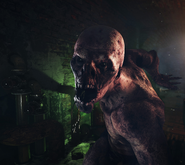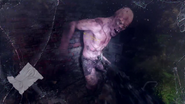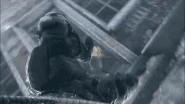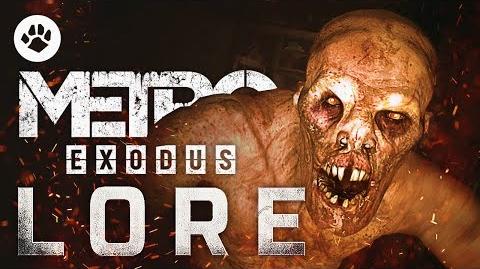Humanimals (Russian: Зверолюди) or Fuglies are a species of mutant encountered on the surface in Metro Exodus. Derived from humans, they hunt in packs and use primitive weapons to attack. They appear in the Volga and Caspian Sea levels, and feature heavily in Sam's Story.
Unlike Dark Ones, which are also derived from humans, Humanimals have been exposed to less radiation outside of the cities, which was sufficient enough to mutate them, they are also less intelligent than Dark Ones.
Overview[]
Although they resemble humans from a distance, humanimals are dangerous and aggressive creatures that attack their sapient relatives on sight. Physically, they are bipedal mutants with pale, dirty skin and no body hair. They have developed sharp claws and teeth, while their noses appear to have rotted away. The most notable difference between them and their human cousins are the feet; humanimals have developed canine-like feet, possibly as an evolutionary advantage, as the humanimal prefers to chase its prey on all fours. It seems to be one of the more common and widely dispersed mutants, and can be found in greatly varied environments ranging from the damp banks of the Volga river to the arid deserts of the Caspian, and can be found as far east as Vladivostok. Generally, it appears that humanimals prefer slightly irradiated urban and industrial environments, but are absent from heavily irradiated metropolitan areas like Moscow or Novosibirsk, as well as remote forests like the Valley. While their appearance may slightly vary from environment to environment, their behavior is not too dissimilar.
Humanimal behavior bears some similarities to the behavior of primates such as using debris as thrown weapons. Similarly to gorillas, humanimal packs are sometimes led by a much larger alpha variation, which appears at least a head taller with much greater muscle mass. These humanimals can withstand and deal greater amounts of damage. Humanimals communicate with each other through screeches and guttural grunts. Humanimals will sometimes stage ambushes by burrowing themselves in mud or sand in areas they know are frequented by humans. Humanimals are also good swimmers, as they can be seen readily jumping into the water in Vladivostok. This behavior is absent in humanimals from the Volga, likely due to the Tsar Fish actively preying on them. They can easily climb walls, and sleep on foot, even during the day. Their usual hunting tactic is to hide under the water, sand, or grass, attacking their prey when they approach.
Although a single humanimal doesn't pose much threat to a well-trained ranger, a group of them can quickly and easily overwhelm even the most skilled post-apocalyptic warriors. It is best to keep a distance when fighting these mutants. Use of ranged weapons is advised, rather than hand-to-hand combat.
Humanimals can be tamed, and make an excellent pool of cheap labor due to their strength and low food consumption. Humanimal trapping and domestication has become a major part of Vladivostok's economy, where the beasts are captured, domesticated or tamed, then sold to traders from the south. Despite survivors often deriding their intelligence, it appears that humanimals can learn rather quickly, as evidenced by comments from trappers who hunt them. They also have entertainment value as they can also be trained as gladiators and pit fighters. There is even a recorded instance of a captured humanimal pretending to be sick, only to escape its cage later, suggesting an even higher level of intelligence that places them among the most intelligent mutants in the wasteland.
Trivia[]
- Although humanimals do not appear in the main installments of the Metro Series until Metro Exodus, similar creatures have been seen years earlier in various novels of the Universe of Metro 2033. These humanoid mutants, their bodies twisted by two decades of exposure to radiation and the harsh conditions of life on the surface, are crazed/went insane and will attack anything (including their human cousins) to feast on their flesh.
- In The Roots of Heaven there are similar mutants nicknamed "Zombies" (undead, puppets). They have long sharp claws, yellowish skin, black eyes without pupils, and "spreading" noses and eyes. They continue to decompose. Most likely they appeared this way due to the use of bacteriological weapons and chemicals that altered their DNA.
- Humanimals bear a resemblance to several monsters and creatures from popular culture:
- Their appearance bears striking resemblance to Mythological Vampires such as Nosferatu and Upir.
- They also resemble ghouls, both the mythological type and, more closely, the feral ghouls from the Fallout series. Both are humans mutated by radiation, becoming crazed cannibals that attack almost everything on sight.
- They closely resemble the vampiric infected from the movie I Am Legend.
- The movement of humanimals and their tendency to roam and attack in packs makes them appear similar to zombies.
- While Duke calls the creatures "humanimals" at the Volga, multiple regions have their own names for the creatures. Katya refers to them as "beastmen" during a conversation about the port Krest had taken refuge in, while at the Volga, Damir names the ones found in the Caspian Sea "chameleons", due to their tendency to blend in with the environment and then ambush their prey, while residents of Vladivostok call them "fuglies". Indeed, humanimals along the Volga and in Vladivostok exhibit a different color scheme than those in the Caspian, both blending it with their respective environments.
- It's also mentioned in Vladivostok that humanimals may reproduce, as local hunters have avoided completely clearing an islet in the city's lower marsh region as the humanimals there are notably tougher compared to others in the city and fetch a higher price because of this. So, the hunters avoid clearing the islet to let them reproduce.
- When not actively hunting, humanimals can sometimes be seen wandering about or even standing still, seemingly in a daze and unaware of their surroundings until they are attacked or hear a loud noise.
- It's possible to stealth kill or knock out humanimals. However, they cannot be knocked out once engaged in combat. Knocking them out has no effect on moral points or story progression.
- The humanimals' capacity for domestication shows that despite their higher degree of mutation and devolution, the species still possesses a level of intellect, which is just enough to be a menial labor force. They are also considerably stronger than an average human, making them quite suited for turning wheels and dragging carts.
- They can also be taught to do more complex tasks, such as retrieving fish from the water after the fish are killed with dynamite.
- Humanimals can also be trained as "guard dogs", but are not as suited to this task as actual dogs, partially because they consume more resources.
Gallery[]
Videos[]
| Creatures of the Metro Series | |
|---|---|
| Terrestrial Animals | Bear • Biomass • Corpse Eaters • Deer • Dog • Giant Amoeba • Hare • Lurker • Nosalis • Nosalis Rhino • Pigs • Snake • Spiderbug • Slimeslug • Watcher (Watchman) • Wolf |
| Avian Animals | |
| Aquatic Animals | |
| Plant Life Forms | |
| Humanoids | |
| Supernatural Phenomena | |









